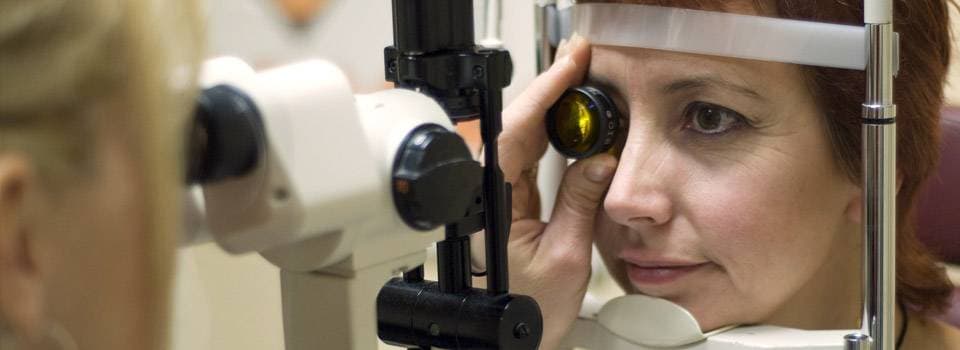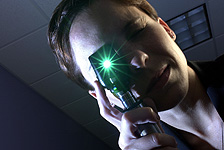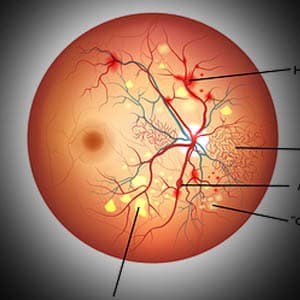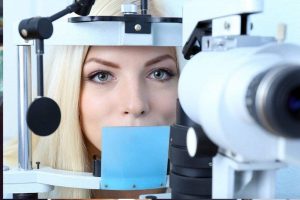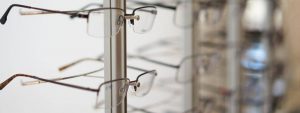If you have been diagnosed with diabetes, annual eye exams will help to protect your eyes from serious sight-threatening eye diseases.
Diabetes is a condition that prevents the body from using and storing sugar properly. As a result, excessive amounts of sugar remain in the bloodstream and if uncontrolled, can cause damage to the tiny blood vessels all over the body, including those in your eyes.
Diabetic retinopathy affects 30 percent of people with diabetes.
Diabetic retinopathy occurs when the blood vessels inside the eye start to leak blood and fluid into the retina, causing damage and permanent vision loss. Early detection and treatment is crucial for preserving your eyesight.
Diabetic macular edema (DME) is a complication of diabetic retinopathy, and occurs when the macula, the center of the retina, begins to swell. The macula is responsible for your central and color vision. When the macula swells, it damages the blood vessels, causing them to leak— resulting in vision loss.
While patients with uncontrolled blood sugar levels have a higher risk of diabetic retinopathy, those with controlled diabetes are still at risk.
For this reason, eye doctors recommend annual eye exams for early detection of the disease, and increased optimal treatment results. By regularly monitoring your ocular health, you are ensuring that any changes that occur will be detected early, before they can cause any harm.
How is a diabetic eye exam different from a regular eye exam?
Diabetic eye exams are similar to regular eye exams in many ways. However, during a diabetic eye exam, your eye doctor will specifically focus on the health of your retina and integrity of the blood vessels in your eye.
1. Pupil dilation
Every diabetic eye exam requires pupil dilation for a clear view of your eyes’ inner structures— specifically, your retina, optic nerve, and blood vessels in the back of your eye.
Your eye doctor will dilate your pupils by inserting special eye drops into your lower eyelids. The eye drops take about 30 minutes to work, and typically cause temporary blurred near vision and light sensitivity. These side effects generally subside within a few hours.
In some cases, after a retinal exam, additional tests will be recommended for further examination, such as a fluorescein angiography or optical coherence tomography.
2. Fluorescein angiography
This test enables detection of damaged blood vessels in your eye. A special dye will be injected into your arm, and will travel through your bloodstream to your eyes, highlighting any blood vessel damage. A special camera will then take pictures of damage found, for easy identification.
If you have diabetes, contact an eye doctor near you, who can diagnose and discuss the best treatment options.
SEE RELATED: Diabetes: Why You Shouldn’t Skip Your Eye Exams
3. Optical coherence tomography (OCT)
This imaging test provides images of the cross-sections of your retina, to enable a clear view of the fine details, and detection of any thinning or thickening blood vessels that indicates leaking fluid.
4. Glaucoma test
Early diagnosis of glaucoma is crucial for early treatment of this sight-threatening disease. Glaucoma is nicknamed “The Silent Thief of Sight” because it generally does not show any symptoms until permanent vision loss has occurred.
Therefore, monitoring changes to the pressure within your eyes (intraocular pressure) that may rise as a result of natural eye fluid build-up, is crucial. If high pressure is noted, it may indicate the presence of glaucoma.
Testing for glaucoma usually involves the “puff-of-air” test, in which your eye doctor will aim a tonometer towards your open eye. The tonometer lets out a puff of air and then calculates your intraocular pressure based on your eye’s response to the air.
5. Vision test
The vision test measures your vision clarity for distant images, and is an important part of every eye exam.
During this test, you will be asked to identify large and small letters on a distant eye chart. Each eye is tested separately to identify any visual discrepancies between the two eyes.
When do I need a diabetic eye exam?
- If you have type 1 diabetes: Schedule eye exam within five years of your diagnosis.
- If you have type 2 diabetes: Schedule an eye exam immediately following your diagnosis. This type of diabetes is often only diagnosed years later, and detection of possible retinal damage is critical.
- Pregnant women with diabetes: Schedule an eye exam within the first three months of pregnancy, and then again one year postpartum.
After your initial eye exam, eye doctors recommend annual exams for continued monitoring of your ocular health. If your eye doctor detects any changes during an exam, you may be required to return for additional eye exams more than once every year.
LEARN MORE: Guide to Eye Conditions
If you have diabetes, schedule an appointment with an eye doctor for a comprehensive diabetic eye exam.
Diabetes can cause many changes in the body, including within your eyes. Keeping up with annual eye exams, or as recommended by your eye doctor, will help you to maintain your ocular health and preserve your vision— so that you can share in those special moments life presents you.
